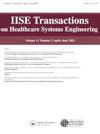A modified SIR model equivalent to a generalized logistic model, with standard logistic or log-logistic approximations
IF 1.5
Q3 HEALTH CARE SCIENCES & SERVICES
IISE Transactions on Healthcare Systems Engineering
Pub Date : 2021-09-01
DOI:10.1080/24725579.2021.1968547
引用次数: 1
Abstract
Abstract A modified version of the three-compartment susceptible-infectious-removed (SIR) epidemic model can be expressed exactly using a specific generalization of the logistic distribution, and its parameters can be estimated from epidemic surveillance data. The population proportion remaining Susceptible may be approximated using the inverse of a standard cumulative logistic distribution, while the population proportion actively Infectious may be approximated using the density of a logistic or log-logistic distribution. This knowledge may enable rapid local disease modeling without specialized skills. Highlights A modification of the three-compartment SIR model can be solved exactly in terms of a specific generalization of the logistic distribution The generalized logistic solution can be approximated using standard logistic and/or log-logistic distributions Surveillance data from an emerging epidemic, often initially modeled with standard logistic or log-logistic curves, can be used to derive parameters for an underlying modified SIR model等效于广义逻辑模型的修正SIR模型,具有标准逻辑或对数逻辑近似
摘要三室易感传染病去除(SIR)流行病模型的修改版本可以使用逻辑分布的特定泛化来精确表达,并且可以根据流行病监测数据来估计其参数。剩余易感人群比例可使用标准累积逻辑分布的倒数来近似,而活跃感染人群比例可通过逻辑分布或对数逻辑分布的密度来近似。这些知识可以在没有专业技能的情况下实现快速的局部疾病建模。亮点三室SIR模型的修改可以根据逻辑分布的特定泛化来精确求解。广义逻辑解可以使用标准逻辑和/或对数逻辑分布来近似。来自新出现流行病的监测数据,通常最初使用标准逻辑或对数逻辑曲线建模,可用于导出基础修改SIR模型的参数
本文章由计算机程序翻译,如有差异,请以英文原文为准。
求助全文
约1分钟内获得全文
求助全文
来源期刊

IISE Transactions on Healthcare Systems Engineering
Social Sciences-Safety Research
CiteScore
3.10
自引率
0.00%
发文量
19
期刊介绍:
IISE Transactions on Healthcare Systems Engineering aims to foster the healthcare systems community by publishing high quality papers that have a strong methodological focus and direct applicability to healthcare systems. Published quarterly, the journal supports research that explores: · Healthcare Operations Management · Medical Decision Making · Socio-Technical Systems Analysis related to healthcare · Quality Engineering · Healthcare Informatics · Healthcare Policy We are looking forward to accepting submissions that document the development and use of industrial and systems engineering tools and techniques including: · Healthcare operations research · Healthcare statistics · Healthcare information systems · Healthcare work measurement · Human factors/ergonomics applied to healthcare systems Research that explores the integration of these tools and techniques with those from other engineering and medical disciplines are also featured. We encourage the submission of clinical notes, or practice notes, to show the impact of contributions that will be published. We also encourage authors to collect an impact statement from their clinical partners to show the impact of research in the clinical practices.
 求助内容:
求助内容: 应助结果提醒方式:
应助结果提醒方式:


